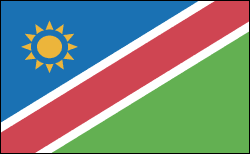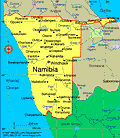Namibia | Facts & Information

- Namibia Profile
- History
- News and Current Events
Infoplease has everything you need to know about Namibia. Check out our country profile, full of essential information about Namibia's geography, history, government, economy, population, culture, religion and languages. If that's not enough, click over to our collection of world maps and flags.
Facts & Figures
-
President: Hage Geingob (2015)
Prime Minister: Saara Kuugongelwa-Amadhila (2015)
Total area: 318,694 sq mi (825,418 sq km)
Population (2013 est.): 2,182,852 (growth rate: 0.817%); birth rate: 21.11/1000; infant mortality rate: 45.61/1000; life expectancy: 52.17
Capital and largest city (2009 est.): Windhoek, 342,000.
Monetary unit: Namibian dollar
Languages: Oshiwambo languages 49.7%, Nama/Damara 11%, Kavango languages 10.4%, Afrikaans 9.4% (also a common language), Herero languages 9.2%, Zambezi languages 4.9%, English (official) 2.3%, other African languages 1.5%, other European languages .7%, other 1% (2016 est.)
Ethnicity/race: black 87.5%, white 6%, mixed 6.5%. Note: about 50% of the population belong to the Ovambo tribe and 9% to the Kavangos tribe; other ethnic groups are Herero 7%, Damara 7%, Nama 5%, Caprivian 4%, Bushmen 3%, Baster 2%, Tswana 0.5%
Religions: Christian 80%–90% (Lutheran at least 50%), indigenous beliefs 10%–20%
National Holiday: Independence Day, March 21
Literacy rate: 88.8% (2010 est.)
Economic summary: GDP/PPP (2012 est.): $16.84 billion; per capita $7,800. Real growth rate: 4%. Inflation: 5.8%. Unemployment: 51.2%. Arable land: .99%. Agriculture: millet, sorghum, peanuts, grapes; livestock; fish. Labor force: 818,600; agriculture 16.3%, industry 22.4%, services 61.3% (2008 est.). Industries: meatpacking, fish processing, dairy products; mining (diamonds, lead, zinc, tin, silver, tungsten, uranium, copper). Natural resources: diamonds, copper, uranium, gold, lead, tin, lithium, cadmium, zinc, salt, vanadium, natural gas, hydropower, fish; note: suspected deposits of oil, coal, and iron ore. Exports: $4.657 billion (2012 est.): diamonds, copper, gold, zinc, lead, uranium; cattle, processed fish, karakul skins. Imports: $5.762 billion (2012 est.): foodstuffs; petroleum products and fuel, machinery and equipment, chemicals. Major trading partners: South Africa, U.S. (2006).
Communications: Telephones: main lines in use: 140,000 (2011); mobile cellular: 2.24 million (2011). Broadcast media: 1 private and 1 state-run TV station; satellite and cable TV service is available; state-run radio service broadcasts in multiple languages; about a dozen private radio stations; transmissions of multiple international broadcasters are available (2007). Internet Service Providers (ISPs): 78,280 (2012). Internet users: 127,500,600 (2009).
Transportation: Railways: total: 2,626 km (2008). Highways: total: 64,189 km; paved: 5,477 km; unpaved: 58,712 km (2010). Ports and harbors: Luderitz, Walvis Bay. Airports: 112 (2012).
International disputes: concerns from international experts and local populations over the Okavango Delta ecology in Botswana and human displacement scuttled Namibian plans to construct a hydroelectric dam on Popa Falls along the Angola-Namibia border; managed dispute with South Africa over the location of the boundary in the Orange River; Namibia has supported, and in 2004 Zimbabwe dropped objections to, plans between Botswana and Zambia to build a bridge over the Zambezi River, thereby de facto recognizing a short, but not clearly delimited, Botswana-Zambia boundary in the river.









